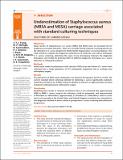Files in this item
Underestimation of Staphylococcus aureus (MRSA and MSSA) carriage associated with standard culturing techniques : One third of carriers missed
Item metadata
| dc.contributor.author | Tsang, S. T.J. | |
| dc.contributor.author | McHugh, M. P. | |
| dc.contributor.author | Guerendiain, D. | |
| dc.contributor.author | Gwynne, P. J. | |
| dc.contributor.author | Boyd, J. | |
| dc.contributor.author | Simpson, A. H. R. W. | |
| dc.contributor.author | Walsh, T. S. | |
| dc.contributor.author | Laurenson, I. F. | |
| dc.contributor.author | Templeton, K. E. | |
| dc.date.accessioned | 2020-09-11T11:30:02Z | |
| dc.date.available | 2020-09-11T11:30:02Z | |
| dc.date.issued | 2018-01-12 | |
| dc.identifier | 270078795 | |
| dc.identifier | bfe9cbad-d43c-4f14-b589-386c4f0d8ba6 | |
| dc.identifier | 85040583903 | |
| dc.identifier.citation | Tsang , S T J , McHugh , M P , Guerendiain , D , Gwynne , P J , Boyd , J , Simpson , A H R W , Walsh , T S , Laurenson , I F & Templeton , K E 2018 , ' Underestimation of Staphylococcus aureus (MRSA and MSSA) carriage associated with standard culturing techniques : One third of carriers missed ' , Bone & Joint Research , vol. 7 , no. 1 , pp. 79-84 . https://doi.org/10.1302/2046-3758.71.BJR-2017-0175.R1 | en |
| dc.identifier.issn | 2046-3758 | |
| dc.identifier.other | ORCID: /0000-0002-0370-3700/work/80257891 | |
| dc.identifier.other | ORCID: /0000-0002-7536-1308/work/80257962 | |
| dc.identifier.uri | https://hdl.handle.net/10023/20608 | |
| dc.description | This research was supported by the Royal College of Surgeons Edinburgh (Joint RC SEd/Cutner Research fellowship awarded to S. T. J. Tsang), Leonardo (Selex Medical) (Research grant awarded to T. S. Walsh), and Arthritis Research UK (Research grant awarded to A. H. R. W. Simpson). | en |
| dc.description.abstract | Objectives Nasal carriers of Staphylococcus (S.) aureus (MRSA and MSSA) have an increased risk for healthcare-associated infections. There are currently limited national screening policies for the detection of S. aureus despite the World Health Organization’s recommendations. This study aimed to evaluate the diagnostic performance of molecular and culture techniques in S. aureus screening, determine the cause of any discrepancy between the diagnostic techniques, and model the potential effect of different diagnostic techniques on S. aureus detection in orthopaedic patients. Methods Paired nasal swabs for polymerase chain reaction (PCR) assay and culture of S. aureus were collected from a study population of 273 orthopaedic outpatients due to undergo joint arthroplasty surgery. Results The prevalence of MSSA nasal colonization was found to be between 22.4% to 35.6%. The current standard direct culturing methods for detecting S. aureus significantly underestimated the prevalence (p = 0.005), failing to identify its presence in approximately one-third of patients undergoing joint arthroplasty surgery. Conclusion Modelling these results to national surveillance data, it was estimated that approximately 5000 to 8000 S. aureus surgical site infections could be prevented, and approximately $140 million to $950 million (approximately £110 million to £760 million) saved in treatment costs annually in the United States and United Kingdom combined, by using alternative diagnostic methods to direct culture in preoperative S. aureus screening and eradication programmes. | |
| dc.format.extent | 6 | |
| dc.format.extent | 536311 | |
| dc.language.iso | eng | |
| dc.relation.ispartof | Bone & Joint Research | en |
| dc.subject | Periprosthetic joint infection | en |
| dc.subject | Staphylococcus aureus | en |
| dc.subject | Surgical site infection | en |
| dc.subject | RD Surgery | en |
| dc.subject | Surgery | en |
| dc.subject | Orthopedics and Sports Medicine | en |
| dc.subject | NDAS | en |
| dc.subject.lcc | RD | en |
| dc.title | Underestimation of Staphylococcus aureus (MRSA and MSSA) carriage associated with standard culturing techniques : One third of carriers missed | en |
| dc.type | Journal article | en |
| dc.contributor.institution | University of St Andrews. School of Medicine | en |
| dc.contributor.institution | University of St Andrews. Infection and Global Health Division | en |
| dc.identifier.doi | 10.1302/2046-3758.71.BJR-2017-0175.R1 | |
| dc.description.status | Peer reviewed | en |
This item appears in the following Collection(s)
Items in the St Andrews Research Repository are protected by copyright, with all rights reserved, unless otherwise indicated.

